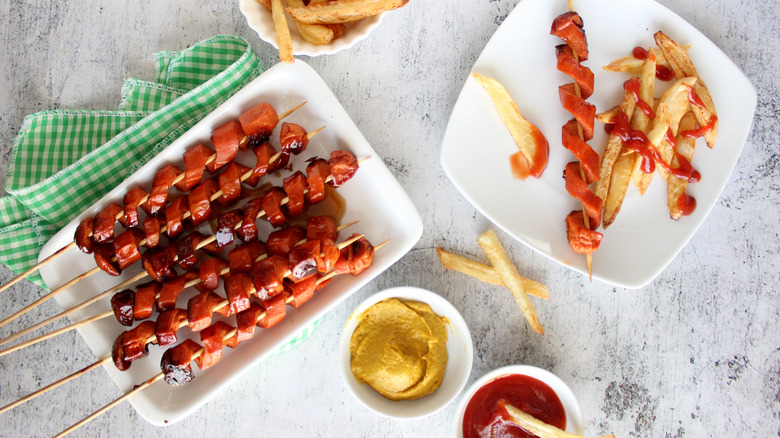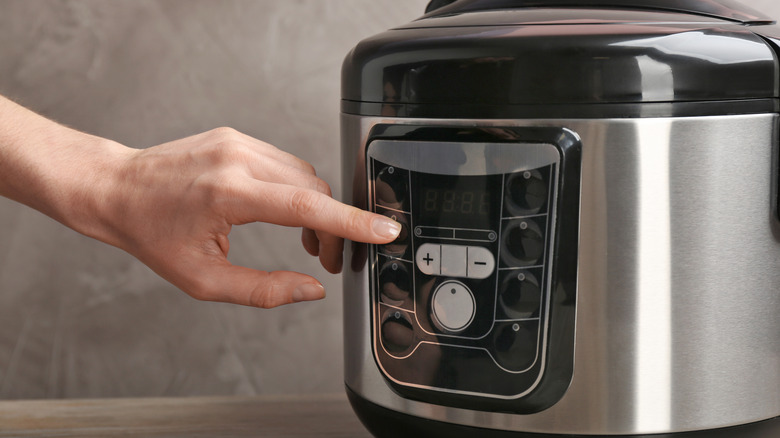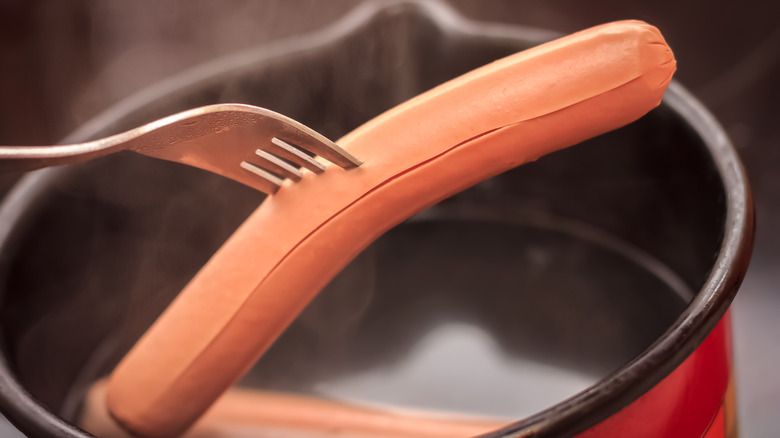12 Fun Hot Dog Hacks You Need To Try
The humble hot dog has a long and storied history. While sausages have existed since ancient times, the birth of the hot dog came about much later — sometime between the 15th and 17th centuries, depending on whose story you believe. It came to be somewhere in Europe, before making its way across the Atlantic, as people immigrated to the Americas. Over time, the long, thin sausage grew in popularity in the United States. By the late 19th century, hot dogs were gracing ballparks across the country.
While a classic, no-frills hot dog is certainly satisfying, it's also a great food to experiment with. From unconventional cooking techniques to unique toppings to creative twists on the classic bun, there are so many ways to maximize the flavor of a hot dog while trying something new. These hacks will work, no matter what type of hot dog you're preparing — whether it's an all-beef frank, a turkey dog, or a vegan version. Keep this list on hand for your next barbecue, game day, or whenever you're in the mood for a distinctive dog.
1. Spiralize your dogs
The shape of a hot dog is simple and functional. It fits right in the bun, which fits in your hand, which fits perfectly into your mouth. But there is a way to reshape the sleek tube to give it a bit of pizazz. It takes practice to get it perfect, but once you have a spiralized hot dog, you may never be satisfied with a basic one again. Spiral dogs not only taste great, but they also look impressive, too.
This technique works best with direct heat, which can work to create crispy edges on your spiralized dog. If you're planning to steam or boil your hot dogs, it won't offer you any advantages. But if you are grilling or frying these spiralized sausages, what you'll end up with is a wonderfully textured dog, covered in crevices that are perfect for harboring all manner of toppings. Unlike with a normal-shaped dog, you can pack on as much mustard, onion, sauerkraut, and relish as you want. The toppings will stay put in the grooves, instead of sliding off.
An easy way to make the spiral cut is to skewer your hot dogs first, then hold the knife at an angle, spinning the skewer as you cut. You can also do this without the skewer, using your other hand to hold and turn the dog against the knife. Remember to be careful if using this method.
2. Wrap them in bacon
Bacon makes everything better, adding its salty, meaty goodness to whatever dish it graces. You can use bacon strips or bacon crumbles as hot dog toppings, but to really get the full bacon effect, you'll want to start wrapping. Bacon-wrapped hot dogs are rich and smoky, and fill the air with a glorious aroma as they cook. What you lose by covering up the snappy casing of the dog, you gain in exceptional savory flavor and crispy, fatty texture.
There are a few tricks to successfully wrapping your dogs in bacon. First, make a few shallow slits or holes in the hot dog's exterior to help keep it from swelling as it cooks. Next, as you wrap your bacon slices around it, try to avoid overlapping, so that the bacon cooks evenly. Use a toothpick to secure the strip of bacon on both ends, if need be. Thin slices are typically better to deal with, as they'll cook through faster.
You can cook bacon-wrapped dogs over the grill, in a frying pan, or even in the oven. Make sure you're keeping a close eye, rotating the dogs as needed so that all of the bacon's surface gets crisped up. If you want to go really hog wild, you can top your bacon-wrapped hot dogs with more bacon.
3. Marinate them first
While you may instinctively marinate chicken, pork, or steak, giving hot dogs a flavorful bath before cooking them may have never crossed your mind. Hot dogs are already seasoned and cooked, so you can pop them right out of the package and onto your plate with just a few minutes of cooking. But if you're looking to add a more unique flavor to your hot dogs, you can absolutely marinate them before cooking.
Since hot dogs are encased, you'll need to give the marinade a little help to be able to penetrate the meat. A few shallow slits will do the trick, or you can make a more elaborate pattern like cross-hatching. The main thing is to expose the interior of the dog before you submerge it. As far as the marinade goes, that's purely up to individual taste.
You don't need to leave them immersed for too long — half an hour will usually suffice, although you can leave them longer for more intensity. One thing to keep in mind is saltiness, as hot dogs are typically assertively seasoned, so you don't want to overdo it with a salty marinade. Be mindful of ingredients like soy sauce, if adding them to your marinade mixture.
4. Split them down the middle
To get a similar effect as a spiralized dog — without the intricate knife work — simply slice it down the middle. One quick knife slice from end to end is all it takes. Just make sure not to cut all the way through, so that the hot dog stays in one piece.
This essentially butterflies the dog, increasing the surface area that comes in direct contact with heat, so you'll end up with double the amount of crispy browned edges. The other advantage of a butterflied dog is that it stays put on the grill or pan and won't roll around, so it's more of a hands-off cooking experience. Just set it down, flip it once, and you're done.
The split down the center of a hot dog also allows you to throw on mountains of toppings. Packing condiments and relishes and all the other goodies in between the two hot dog halves keeps them from spilling onto the outer bun or slipping off the surface. Butterflied dogs also heat through faster — not that hot dogs take a long time to cook either way. But if you're cooking for a hungry crowd, every minute counts.
5. Stuff them
Something of a cousin to the butterflied dog, the stuffed dog takes that technique and brings it up a notch. To stuff a dog, you need to somehow get the toppings, and turn them into fillings, by placing them inside the sausage. The easiest way to do that is to split the dog down the middle, place the fillings inside, and then connect the halves back together. This can be done by wrapping it tightly with something, like bacon or a tortilla. You can also use toothpicks.
The most common filling is cheese. This melts nicely inside the dog, making sort of a hot dog version of a Juicy Lucy burger. Just be careful when you bite into it, as the cheese can resemble molten lava if you eat it while it's too hot. Cheese isn't the only ingredient that makes a good filling. Any ingredient that is better with a little cooking is a good candidate for stuffing your dog with. Consider diced jalapeños, onions, tomatoes, or a combination of all three.
6. Wrap them in tortillas and fry them
Tortillas make perfect vessels for hot dogs. Ingredients like cheese, onions, and peppers can be wrapped inside, along with the franks, so that they all cook together. Then, the whole package can be baked, pan-fried, deep-fried, air-fried, or even grilled. The result is a tasty tube filled with oozy, meaty goodness similar to a taquito or a flauta.
Corn tortillas are a great option for hot dog fans who are avoiding gluten. Flour tortillas also work well, so it's really a matter of diet and personal preference. The disadvantage to using a tortilla is that it's harder to hold toppings, as there are no crevices on which to place them. But if you're all about the toppings, you can always use a knife and fork. On the other hand, you could throw your favorite condiments and toppings together in a bowl and use your tortilla-wrapped hot dogs to dip into them.
7. Use a slow cooker to make large batches
You don't have to spend the entire cookout standing over a hot grill, throwing on batch after batch of hot dogs. Slow cookers are a great solution when you need to cook hot dogs in bulk.
The size of your slow cooker will determine how many dogs you can heat at once. If it's tall enough and the dogs are short enough, you can pack the most in if you place them vertically — think of a can of Vienna sausages. Otherwise, laying them on their sides is fine too. An hour or two on high — or a few more hours on low — and you'll have a mega batch of cooked hot dogs. While they're cooking, keep the lid on to circulate moisture so they don't dry out. Once they're ready, you can switch your cooker to the warm setting, and it'll keep them ready to go throughout the whole party.
8. Multiply your meats
Sometimes you might be in the mood for a classic frankfurter, while other times you might want a classic sausage. Other times, you might want both. We think you should be able to have both at the same time. There's no reason to deprive yourself of multiple meats on one bun, and it's pretty easy to get the best of both worlds.
To get two different types of sausage in each bite — but not overload your bun or your mouth — slice both in half lengthwise. Then, cook each half separately. Finally, place them together in the bun with the centers touching, as if you're putting a whole sausage back together. Once the halves are nestled in the bun, you'll get a double wallop of flavor in each bite — provided they're the same or similar size.
When creating these half-and-half dogs, be wary of the style of sausage you're using. It's best to pair hot dogs with other sausages that are already fully cooked, as they'll heat up at the same rate and there will be no danger of contamination from raw meat. Look for "fully cooked" or "ready to eat" on the label.
9. Think beyond the basic bun
Buns and tortillas are not the only ways to serve hot dogs. The carbohydrate possibilities are virtually endless. You can serve a dog naked, of course, on a plate or a skewer. But if you like your hot dog with an outer shell, don't limit yourself.
Similar in shape and size to a basic hot dog bun, you can find long brioche rolls in many markets and bakeries. Brioche is made from enriched dough, which is sweeter and richer, thanks to the inclusion of ingredients like butter and eggs. Pretzel buns are a phenomenal choice for hot dogs, with a solid exterior that stays together even under a mountain of toppings. Puff pastry can be wrapped around hot dogs and then baked, like full-sized pigs in a blanket. Croissant dough can be utilized for the same purpose.
While soft tortillas make great wraps or vehicles for deep-frying, crispy tortillas are fun to use with hot dogs, too. Place the dog at the bottom of the shell, and you can load the rest up with your favorite toppings. If you can find bolillos, which are a type of Mexican roll shaped like a football, they're perfect for hot dogs. They're the classic style of bread used to make Sonoran dogs, a specialty of Mexico that's become incredibly popular in the American southwest. The size of these rolls allows for generous toppings, typically beans and salsa.
10. Skewer them
Hot dogs on sticks are nothing new. If you've been camping, you've most likely enjoyed a hot dog skewered and cooked over an open flame. Whether you're gathered around a campfire or a backyard grill, the next time you're cooking hot dogs on sticks or skewers, you can turn it into a whole meal with a few more ingredients and a little bit of knife work.
Instead of skewering the hot dog whole, slice it into chunks horizontally. Skewer each piece, alternating with other ingredients. You'll want to choose foods that will cook well, and fairly quickly since the small pieces of hot dog won't need much time to heat up. Onions and peppers are perfect. Vegetables like mushrooms, cherry tomatoes, and zucchini work well too. You can even add potatoes, as long as they've been partially cooked beforehand. Certain cheeses that hold their shape on the grill make tasty additions, like halloumi.
Other meats can be added to your hot dog skewer too, if you're more of a carnivorous eater. Just make sure the cooking is timed correctly so you don't end up with an undercooked hunk of steak or a dried-out husk of a hot dog. Once everything on the skewer is cooked, you can eat right off of it — just be careful of the sharp end and hot skewer– or unload the ingredients onto a plate or into a bun.
11. Cook your dogs in wine, beer, or stock
If you're boiling or steaming your dogs, you probably start by filling your pot or pan with water. That's a perfectly fine way to get them heated up, but if you want to add an extra dose of flavor, either add to or replace that water with a liquid that has a little more to it.
Chicken, beef, or vegetable stock are all good liquids to use. These will add a delicious savory dimension to your dogs. If using store-bought stocks, try to find ones that have either no salt or reduced salt, since hot dogs are already seasoned. Wine and beer are fantastic for cooking dogs, and offer endless variety. An elegant white wine like Riesling will add delicate fruitiness, or you could go with a rich, peppery Syrah to give your dogs a deep, spicy flavor. A light lager will imbue just a hint of beer flavor, while a dark stout brings some burnt notes that can mimic the char from a grill.
Even if you prefer grilled or fried hot dogs, you can cook them using the steam or boiling method first to infuse them with a little of the liquid's flavor. Then give them a quick turn on direct heat, and you get the best of both worlds.
12. Serve them with a hot dog bar
Everyone's taste in hot dogs is different. Some love plain, unadorned meat and bread. Others like to go all-in on toppings, like fans of the Chicago-style hot dog which is loaded to the brim with extra ingredients. There are chili dog lovers. There are even those who only have eyes for sauerkraut. When you're serving hot dogs to a group, it's impossible to make a dog that suits everyone's preference. That's where the hot dog bar comes in.
A hot dog bar is basically just a selection of toppings and condiments laid out so that people can build their own dog to their liking. It can be gourmet and sprawling, or as simple and concise as you wish to make it. Store-bought mustard, sauerkraut, relish, and maybe a diced onion or two, are all you really need for hot dog purists.
But if you want to make a hot dog spread for the ages, you can go all out. Homemade chili, bacon jam, and various homemade pickles are all exciting toppings to offer. You can even make your own condiments from scratch if you're feeling particularly industrious. A well-stocked hot dog bar lets everyone have fun putting their own individual spin on their dog.












